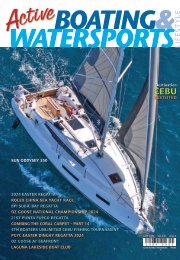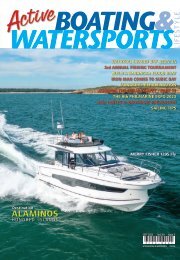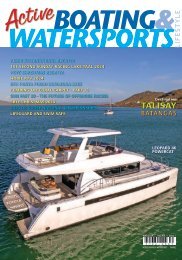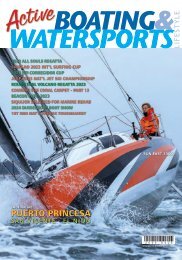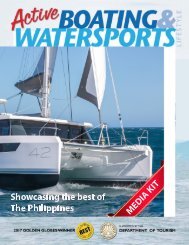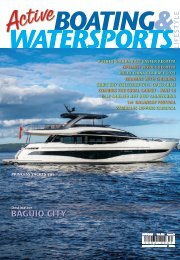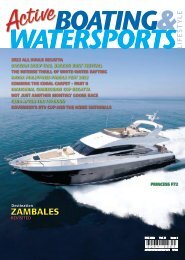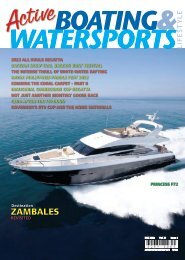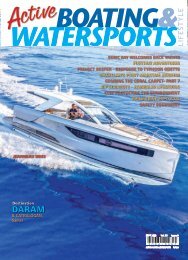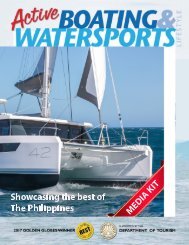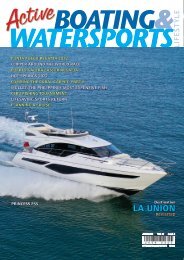ABW Dec 2017
You also want an ePaper? Increase the reach of your titles
YUMPU automatically turns print PDFs into web optimized ePapers that Google loves.
pment for Berthing<br />
Boat at dock<br />
Rope with plastic tubing<br />
Fenders<br />
Fenders are usually made of plastic, although you do<br />
get rope ones occasionally. They are hung over the<br />
side of the boat, tied to the stanchions or grabrails,<br />
and are carefully positioned to prevent the boat from<br />
rubbing against the sides of the berth, or another<br />
boat. They come in a variety of shapes and sizes<br />
to suit the needs of different boats and berthing<br />
situations. You will need at least four large fenders<br />
on board, preferably more. They are, however bulky<br />
and take up a lot of space. Since only the widest<br />
part of the boat normally touches the side of the<br />
berth, you need only position them where the side<br />
of the boat and berth meet. If you are berthed up<br />
alongside an uneven quay wall, you may find it best<br />
to hang a fender board (wooden plank) outside the<br />
fenders to spread the load correctly and protect the<br />
boat.<br />
Cleats and Fairleads<br />
The cleats on your boat should be as large as<br />
possible, since the larger the cleat the less wear there<br />
is on the warp. There should be no sharp edges to<br />
it, and every boat should be equipped with at least<br />
four deck cleats which can be used for mooring.<br />
Bigger boats will need more. If the warps are under<br />
great strain, you should have a Sampson post. Your<br />
boat should have a fairlead on either side, at the<br />
bow and stern, so that the warps do not rub against<br />
the stanchions or rigging. The fairleads can be open<br />
or closed at the top, although the closed type are<br />
safer since the warp cannot slip out accidently.<br />
Warps<br />
The warps used for berthing a boat serve different<br />
functions. Two warps, which form the bow and stern<br />
lines, position the boat correctly in the berth, and<br />
are used by the crew to control the boat’s speed<br />
when coming alongside. The bow and stern lines<br />
have to be strong enough to carry the main load<br />
of the boat and long enough to allow for any rise<br />
and fall of the tide (roughly three times the tidal<br />
range). Two other warps rigged as springs, prevent<br />
the boat from moving backwards and forwards, and<br />
from rubbing against the side of the berth. These<br />
don’t have to be as long as the bow and stern lines:<br />
one and a half times the tidal range is normally<br />
sufficient. The bow and stern lines and the springs<br />
need adjusting as the tide rises and falls. The bow<br />
and stern lines, provided they are long enough,<br />
need only be adjusted at half tide; the springs may<br />
need more frequent adjustment. If you are going<br />
to leave your boat unattended for some time, you<br />
must make sure that you have left enough length<br />
on the lines to allow for the tidal range.<br />
When lying alongside a quay or wall do not lead<br />
the springs through or under the rails, but take<br />
the instead through the fairleads then outside all<br />
the rigging, to prevent chafe on the deck edge or<br />
lifelines as the boat rises and falls with the tide. You<br />
can use fore and aft breast ropes to keep the boat<br />
close alongside when loading, for example. They are<br />
not, however, essential when both bow and stern<br />
lines, and springs are used. When lying alongside a<br />
floating pontoon, they can be used to replace the<br />
bow and stern lines. When about to leave a berth,<br />
you usually rig the lines ashore as slip lines, so that<br />
the crew does not need to go ashore.<br />
79




